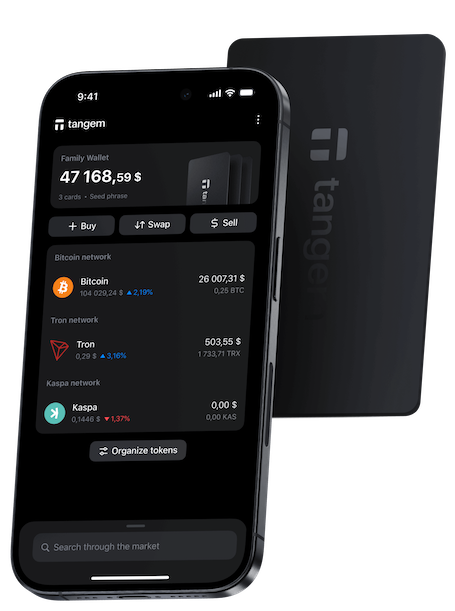
PulseX wallet
The most secure hardware wallet for your PulseX
Join a thriving community of PulseX enthusiasts safeguarding their assets with the Tangem Wallet. Your funds, your control.

How to secure your PulseX with Tangem?
When you buy or hold PulseX in Tangem, it secures your private keys in many ways:
- With the seedless setup and smart backups on extra devices, your Bitcoin is safe and accessible only to you.
- Tangem is IP69K water and dustproof, built to protect against extreme temperatures, EMPs, ESCs, and X-RAYS.
- An access code and biometric authentication protect against unauthorized access.
- Private keys are generated and stored on its EAL6+ CC secure element.
How to get a PulseX Crypto Wallet?
Tangem products are for everyone, from beginners to experts. They keep your crypto safe and easy to manage. With cutting-edge technology, Tangem lets you control and protect your digital assets.
Get TangemWhy choose PulseX wallet with Tangem.
What is PulseX (PLSX)?
PulseX serves as the core exchange hub on the PulseChain network, crafted to enable the trading of PRC20 tokens. It features PLS as its native token alongside PulseX's in-house token, PLSX. The platform works akin to Uniswap on the Ethereum blockchain, delivering a decentralized exchange setting for traders.
What is a PulseX wallet?
A PulseX wallet is designed to store private keys, crucial for managing your PulseX address. It doesn’t store PLSX directly; rather, it enables access to your crypto assets that are on the blockchain. The wallet's fundamental role is to create and hold these keys, facilitating access to your PulseX accounts. Simply put, a PulseX wallet is a tool for storing, sending, receiving, and managing PLSX.
How does a PulseX wallet work?
PulseX wallets operate through pairs of public and private keys to handle blockchain accounts. The private key is vital for accessing a specific PulseX account and must be kept secret, while the public key can be shared to receive PLSX. To retrieve funds, the corresponding private key is essential. Tangem Wallet empowers this by generating and securing private keys within its chip.
What are the types of PulseX wallets?
Exchange PulseX Wallets:
Centralized platforms such as Coinbase, Binance, and Kraken facilitate purchasing PLSX using fiat via custodial wallets, but this involves risks like potential access restrictions.Software PulseX Wallets:
These are software installed on devices for managing private keys and PLSX. User-friendly but prone to malware and cyber threats, encompassing mobile, desktop, and browser variants.Mobile PulseX Wallets:
Applications that allow management of PLSX directly from smartphones.Desktop PulseX Wallets:
Installed on PCs, these store private keys on hard drives or SSDs.Hardware PulseX Wallets:
Secure offline solutions like Tangem, safeguarding against online vulnerabilities.
How to Choose the Best PulseX Wallet
Selecting a wallet hinges on personal requirements, giving weight to ease of use, dependability, longevity, and safety. For substantial holdings or enhanced security from online threats, a hardware wallet, such as Tangem, is an advisable choice.

Tangem supports other cryptocurrencies
Reliability and convenience at your fingertips. Manage thousands of cryptocurrencies with peace of mind anywhere and anytime
See all supported cryptosPulseX FAQ
- A reliable wallet for PLSX should prioritize robust security and user-friendly access. Tangem offers offline protection coupled with straightforward mobile management.
- Software wallets for PulseX are often free, but hardware wallets usually require a one-time purchase. Sending transactions may involve network fees.
- The safest PulseX wallet keeps your private keys offline and protected from unauthorized access. Hardware wallets, such as Tangem, offer the highest level of protection because they isolate keys from online risks.
- A PulseX wallet is a tool that lets you store, send, and receive your digital assets. It manages your private keys, which prove ownership of your PLSX.

